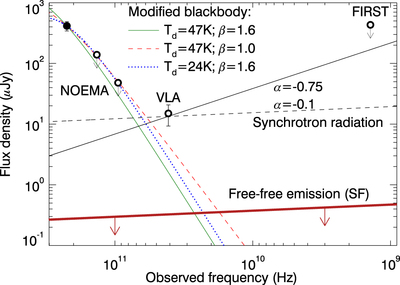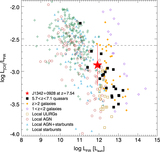Image Details

Caption: Figure 3.
Far-infrared and radio spectral energy distribution of J1342+0928. The data points from left to right represent the NOEMA 1, 2, and 3 mm observations, the tentative VLA 41.0 GHz detection, and the FIRST upper limit. Overplotted are three different dust SEDs scaled to the 1 mm detection and two power laws describing radio synchrotron radiation. The dust model with canonical values (Td = 47 K and ﹩\beta =1.6﹩) agrees well with the upper limits on the continuum emission at 2 and 3 mm, but predicts a much lower continuum flux density at 41.0 GHz. A shallower β (﹩\beta =1.0﹩) or a lower dust temperature (Td = 24 K, slightly above the CMB temperature at z = 7.54), illustrated by the dashed and dotted lines, also predicts a 41.0 GHz flux density below that of the tentative VLA source. The upper limit in FIRST does not provide strong constraints on the slope of the radio emission.
Copyright and Terms & Conditions
© 2017. The American Astronomical Society. All rights reserved.






